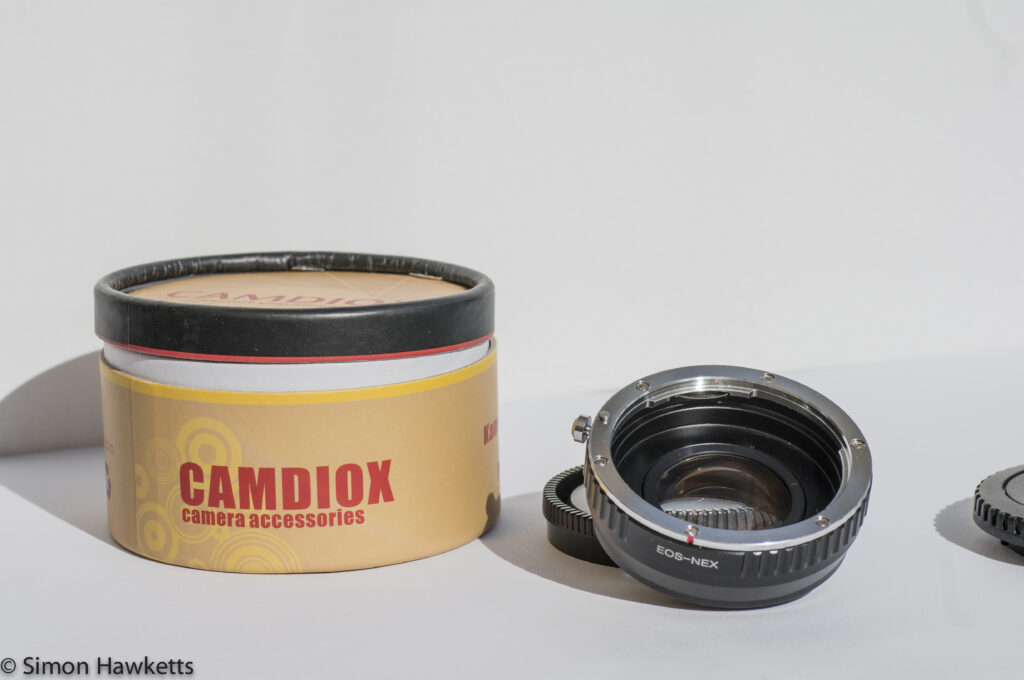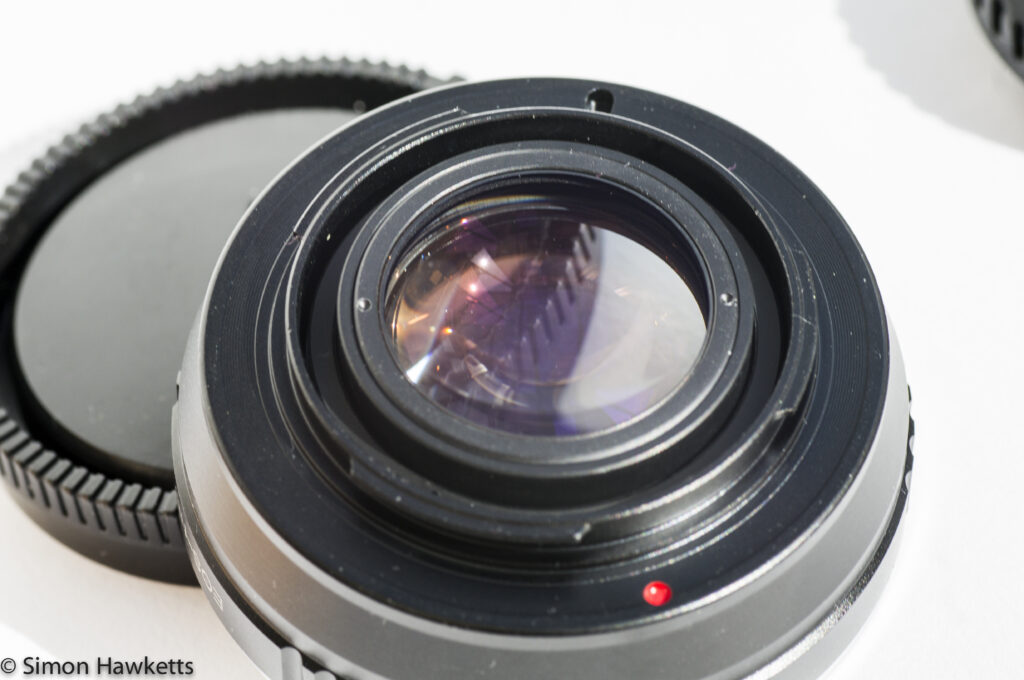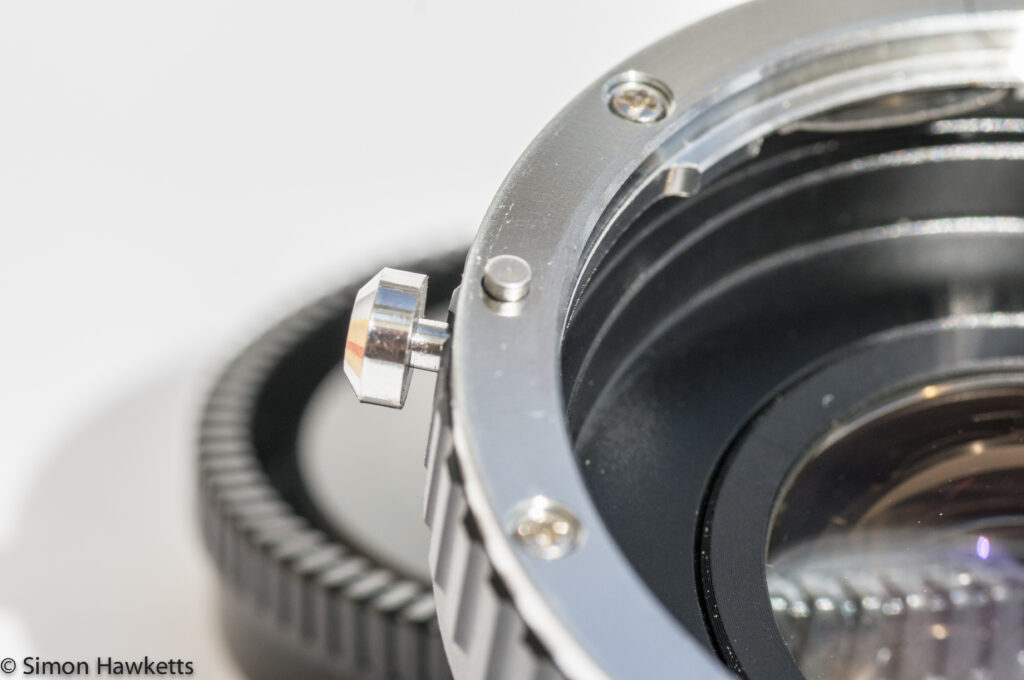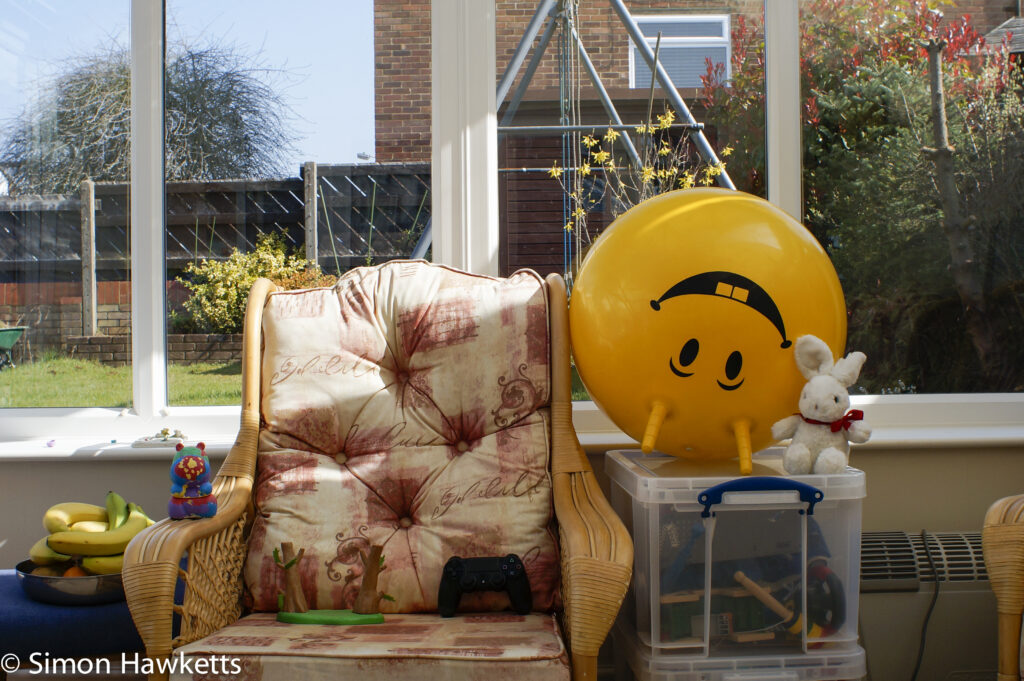Camdiox Canon EOS to Sony Nex focal reducer review
In this post I’m going to review my reasons for purchasing a focal reducer and give my assessment of the performance of the Camdiox unit.
What is a focal reducer?
When I was a teenager (quite a few years ago now I’m sorry to say) I used to own an add-on lens called a teleconverter which fitted behind any lens on my Zenit B slr and doubled the focal length of the lens.
I used it with an inexpensive telephoto lens to try to take pictures of birds feeding in our garden but it was less than successful because the unit was very cheap, (I believe it was a prinzflex which was sold in Dixons at the time) and the images had huge amounts of purple fringing. Also the teleconverter reduced the amount of light reaching the film because the image projected by the lens was much bigger, so the shutter speed had to be reduced to compensate, leading to much more chance of blurry images.
What does all this have to do with a focal reducer?

Well a focal reducer is the opposite of a teleconverter, in fact a more accurate name might be a wide-angle convertor.
Instead of a magnification of 2x, a focal reducer typically has a magnification of around 0.7x which makes the image circle projected by the lens smaller and therefore increases the view angle of the camera. Although this would have been possible years ago there had not been a market for such a product before because on a film camera this would have resulted in the image projected by the lens being smaller that the film frame i.e. very severe vignetting. The reason it is available and popular now is the result of the change to crop sensor cameras with no mirror box like the Sony Nex and Fuji X-E1 etc.
Because mirrorless cameras have a much shorter distance between the sensor and the back of the lens (the registration distance), it’s possible to fit older, classic SLR lenses to them with an adaptor. Many photographers have these lenses from their 35 mm film days, and others are discovering what gems are available for only a few pounds. Obviously, the automatic functions of the camera such as autofocus won’t work and the lenses have to have the aperture set with the adjustment ring on the lens rather than the dial on the camera, but many people look on this as a nostalgic advantage! With these lenses fitted to an APS-C camera it’s possible to take great pictures, but the lenses will always have the crop factor of the lens applied and so will appear to be longer than they actually are.
This is where the focal reducer comes into play.
With a magnification of 0.7 or so the lens will be brought back to something close to the ‘real’ focal length of the lens.
How does this work? Well as an example suppose I’m shooting with a classic 50mm lens. On my NEX 6 I would need to apply the crop factor of the lens so my 50mm would give the same angle of view as a lens of 50 x 1.5 on a 35mm film camera. This makes my pictures look like I’ve taken them with a 75mm short telephoto lens. If I now fit a focal reducer however, I will have an effective focal length of 50 x 1.5 x 0.7 which is 52.5mm so I’m just about back to my 50mm! The focal reducer has removed the crop factor of the sensor.
There is another advantage to this as well.
Since the aperture is just the focal length of the lens divided by the opening in the front of the lens, because the focal length has been reduced the aperture has increased! Now when I first heard this I assumed this was some mathematical calculation and didn’t actually make a difference in real life – but I was wrong. There is actually more light reaching the sensor and any exposure you make will be able to have a faster shutter speed or lower iso as a result. This is because all the light is now falling on the sensor rather than some of it being wasted outside the dimensions of the sensor.
This second effect is the reason the best know of these devices is also known as the speed booster – there is an effective boost in the speed of the sensor.
So this device is a way of getting some great old 35mm film lenses back to their original focal length, restoring a wide angle view, and getting a slightly faster lens into the bargain.
Reasons for purchase
So the last sentence above gives a pretty good indication of why I decided to buy one of these devices – now we come to why I bought the unit I did.
The first focal reducer available, the one which gave the idea the name ‘speed booster’ is the Metabones Speedbooster. This is the first unit I considered because it has been fully reviewed and has a solid reputation. However it is also the most expensive unit at something like $600 (about £370 + postage), and I couldn’t easily find one for sale in the UK.
The next unit I considered is called ‘Lens Turbo’ and is made in China by a company called Mitakon. These are a more attractive price range at about £130 and I could get one with UK delivery, but only in M42 mount. Now, M42 would be a useful mount to get, but I do have some K mount lenses which are designed for full frame cameras so it would make sense to get a unit which would also allow K mount lenses to be fitted.
It was at this point that I decided to do a bit of research into the most adaptable unit to get. I know it isn’t possible to get a K Mount to M42 adapter, at least not a K mount lens to M42 body, so I thought about getting a K mount unit. This would allow me to fit K and M42 lenses but after a bit more research it found that the most adaptable mount is actually the Canon EOS mount.
It’s possible to get cheap metal mount adapters to both K mount and M42 to EOS. These are simple metal ring adapters without glass elements and some quick research suggests it should be possible to get similar adapters for Olympus OM and Nikon which would also open the possibility of fitting other lenses.
So I decided to get an EOS to Sony Nex focal reducer and tried to find one with UK delivery. The one unit I could find is made by Camdiox, so that is the unit I ordered.
Now the obvious question, bearing in mind my problems with a cheap tele-convertor, is why not go for the best unit available since this is going to fit behind a top quality lens?
Well there are several reasons :
- Another supposed advantage of these units is that they are meant to increase image sharpness because of the way they compress the number of lines of detail in the sensor area. I’m not sure that I believe that, but I will find out more when I do the review section of this post.
- I think the Metabones unit is too expensive. To have the unit delivered to the UK would cost almost the price of another Nex 6 body and that is simply too much.
- Another big reason not to spend excessively is that my only real world use case for this device is to restore my wide angle lenses to a wide angle view. I wouldn’t use a focal reducer on a 50mm lens for example; I’d use a 35mm lens and use the crop factor to give me an equivalent of 52.5mm.
- I’ve had my Nex 6 for about 2 months now and I’ve been hugely impressed with it. So much so that I can see my next upgrade path will obviously be to a Sony A7 full frame or the camera which replaces it. If that happens I can still use all my manual lenses and they will have their original focal length anyway, so I will have no need for this unit.
The last reason more than any meant that I didn’t want to spend £300 – £400 and so I settled on what I thought was a Chinese copy which I could get from the uk. I suspect there isn’t a lot to choose between any of the copy units so decided I might as well give the one I found a go.
Description of unit






However it turned out that the last sentence above is actually untrue – the Camdiox unit I bought is actually made in Germany not in China. Just after I placed the order I received a confirmation e-mail which listed the web site of www.roxsen.com so I’m not sure if this is made by Roxsen and sold by Camdiox or the other way round. One thing I can say it that the unit Roxsen sells looks very similar to the unit I eventually received.
I received the unit packaged in a small jiffy bag about 5 days after I placing the order on Ebay. Inside the bag the unit itself is supplied in a small round cardboard container with a push on lid. It looks fairly solid in construction and is supplied with plastic protectors fitted to both mounts.
The first impressions, which struck me when I first opened the box, were the size of the lens in the unit and its weight. For some reason I thought the lens element would be much smaller, although when I think about it that is a bit silly. The lens is about an inch across and has obvious coatings as it has purple/blue reflections when looked at an angle. I noticed the weight when I fitted the unit to the Nex 6 because it was noticeably heavier than with the nex – m42 adapter.
The unit fits to the Nex 6 with a solid click and there is no noticeable slack in the fitting. The lens also clicks nicely into place on the adapter so the whole combination feels pretty solid. The pin which releases the lens from the adapter wiggles about a bit, but that seems common with lens adapters as a whole, and it seems to work well to release the lens.
Adapter tests and sample shots
So now we come to the actual tests of the adapter for which I used my Takumar 28mm f/3.5. I used this lens chiefly because this is the lens which will be most typically fitted to the unit. The process I used is as follows.
I set up a still life arrangement in our conservatory and set the Nex on a tripod with the Takumar fitted via a standard nex-m42 adapter. I then took pictures in aperture priority at all the full stop apertures the lens offers with the iso set to 100. For the purpose of the tests I ignored my usual rule of only shooting in RAW and used Jpeg’s straight from the camera. These pictures are my ‘control group’ and are the best images I can expect from the camera and lens combination.
Next I replaced the nex-m42 adapter with the Camdiox adapter and shot another series of shots in aperture priority at all the same settings and with the iso still set to 100. These shots give the performance of the focal reducer. Obviously the angle of view will be different because the lens will be closer to it’s film setting of 28mm, so I also produced a series of crops in Lightroom which show how the adapter has affected the particular areas of the image we can compare.
Then I replaced the lens / adapter with the standard sony kit lens and set the focal length to 19mm which gives an effective focal length of about 28mm. This was to see if the takumar and focal reducer actually performed better than the kit lens (which is certainly something I’d like to know before I start shooting lots of images with it). A feature of the camera of course is that corrections are automatically applied to jpeg images when the kit lens is fitted, so those shots below will have those corrections applied.
The results of these sessions are shown below arranged in F stop order and I recommend that you look at them in full screen to draw your own conclusions of the tests.




















Conclusions
So I come to my conclusions. Obviously you are able to make your own conclusions from the pictures I’ve supplied, but these are my findings:
- Blurred/Softened corners – The Camdiox adapter has softened the corners of the pictures at the widest aperture of f/3.5 even within the cropped area shot however this is less noticable at f/5.6 and almost gone at f/8.0
- Stop extra speed – The shots with the camdiox fitted do seem to generally be about a stop faster as measured by the shutter speed recorded.
- Definition – When I look in detail in Lightroom at the shots it does seem to me that the center detail in the camdiox shots is slightly improved over the straight Takumar shots.
- The kit lens seems to have produced a slightly warmer picture compared to the other images.
I think the camdiox is a pretty good performer for the £70 I paid. It certainly hasn’t blurred images to the point of making it unpleasant to use but obviously I’ve not yet explored it fully so I intend to use the takumar / camdiox combination over the next few days and give a fuller description of my findings with more real world examples in my next post.








[…] core of the camera kit I’m taking, along with a pentax k mount Soligor 28mm f/2.8 and my camdiox wide angle adapter. With these lenses in the bag I have the following focal lengths at my […]
[…] The majority of these shots were taken with a Soligor 28mm f/2.8 or Takumar 28mm f/3.5 (fitted to a camdiox wide angle adapter which adds a stop approx so probably f/2.8 also) but the real killer feature has been the focus […]
[…] This image was taken with a Takumar 28mm f/3.5 m42 wide angle lens mounted on a Camdiox focal reducer. […]
Hi,
I bought the Camdiox EOS-MFT focal reducer. I haven’t gotten around to testing it yet as I am waiting for a replacement battery for my GH2. I un-boxed the focal reducer when it arrived and realised that the optics assembly wobbles about in the body of the adapter. It can be moved back an forth by about 1mm. I fail to see how this wouldn’t affect focus and sharpness. At this point in time I assume it is a fault in manufacture as I cant see an adjustment screw or anything to fix the optics in place. I have contacted the seller, but thought it might be worth checking with others that have the same product or products like it weather they encountered the same problem. I cant wait to test the adapter as soon as my new battery arrives.
Hi David
That certainly sounds wrong. The optical assembly in my unit is rock solid and as you say any movement would affect the focus. Hope you get it sorted soon because when it’s working it seems quite a good unit.
Thanks a lot for that confirmation. I am really looking forward to testing it.
Best thing since sliced bread !
I have a cupboard full of 35mm lenses whose focal lengths are too long with my E-PM2 micro 43.
Now my Tamron 28-210 f 3.8 spherical which without adaptor is 56-420 mm is a more useful 46-360 ish
f 2.9 and my Chinon Tomioka 50mm f 1.4 is instead of being 100mm is now a beautiful 85mm astonishing
f 1.0. I’ve checked and it really is a stop faster. Where would you get an f1.0 lens for £45 ?
remember with micro 43 the crop factor is 1.7 with adaptor not 1.5 as with APSC
Thanks for your review Simon. I am thinking og getting a Sony A7r or A7s, (have not made my mind up yet). Is the adapter a full frame sensor or APF-C ? I already use the original Metabones EF to NEX on my Nex 7 but this does not work full frame only Apf-c and as you said the latter adapters are too expensive. Would be obliged for your comment on this. Regards Vic
Hi Vic
The adaptor is designed for APS-C sensors so wouldn’t work with a full frame. On a full frame you would get an APS-C sized image circle in the middle of the full frame sensor.
Thanks for the info – had been looking at these and did wonder if the huge price difference between this and the metabones meant quality would be an issue, your pics were very helpful.
Glad they helped
[…] Nex adapter, or I could fit it to any of my M42 fit 35mm cameras if required. I could also use my Camdiox focal reducer with an M42 to Eos adapter, which is how i use my takumar series of lenses when I want to shorten […]
[…] these pictures were taken with either a takumar 28mm f/3.5 or a takumar 50mm f/1.8 and had a camdiox focal reducer fitted to negate the Nex’s 1.5 crop […]
[…] lens used was a takumar 55mm f/1.8 fitted on a camdiox focal reducer which gives an effective max aperture of about f/1.2. The post processing was done in Lightroom 5 […]
[…] of these shots were taken with either a takumar 28mm f/3.5 or takumar 55mm f/1.8 fitted to my camdiox focal reducer. The raw shots were processed in Lightroom 5 before […]
[…] a small camera bag with my Nex 6, Tamron 90mm macro lens, soligor 28mm f/2.8, takumar 28mm with Camdiox focal reducer and Tamron 10-18mm super wide angle and also took my Nikon F80 because I wanted to try some film […]
[…] Tamron 10-24mm super wide angle along with a Takumar 28mm f/3.5 and Takumar 55mm f/1.8 to use on my Camdiox focal reducer. As it happens I mostly used the longest of those lenses, the 55mm Takumar with the camdiox, […]
[…] Camdiox focal reducer […]
[…] which are dark places, so a lot of these pictures were taken with wide apertures and using my camdiox focal reducer, which adds about a stop to each lens attached, but even so a lot needed quite high ISO to reduce […]
[…] Takumar 28mm f/3.5 (some with Camdiox focal reducer) […]
[…] Camdiox m42 to nex Wide Angle Adapter […]
Simon,
Two years later, would you recommend this as a way to use M42 and K-mount lenses on digital?
In particular I’m curious whether you had issues with wider lenses hitting the glass in the focal reducer, as some commenters on pentaxforums have reported.
Hi
Actually I would recommend it yes. I’ve had no issues personally with any lenses fouling the elements of the convertor and found it to be a useful addition to me kit. I’ve actually changed to a Fuji X-T1 since I wrote that article and I’ve been thinking about buying the same unit in fuji x mount.
Fantastic, thank you! I already have a number of M42->EF and K->EF adapters anyway to use these lenses with my Canon 5D, but of course using K lenses on the Canon means snipping off the aperture lever and then they’re not as useful with my film bodies.
Hi Simon.
I’ve just started looking at focal reducers, in particular the Camdiox. User reviews are thin on the ground so thanks for taking the time to do one.
In the reviews I’ve seen, the same thing comes up – with the Camdiox, the image isn’t as sharp wide open as without. But there’s no recognition that in looking at corners, you’re not testing the same area of lens. With a crop sensor, the corners of the image are not the corners of the lens. With the Camdiox fitted, they are. And the corners of old glass do deteriorate in image quality. With a focal reducer you’re getting all of the lens. Without, you’re getting a centred portion.
For me, looking at pentax K to micro four thirds – what happens with the central portion is a fair test on whether quality is reduced. Looking at the edges less so, as apples are not being compared with apples, You’re looking at the edges of the image to compare, when, to compare performance of adaptor (rather than end result), you should look at the edges of a crop for the focal reducer adaptor shot, with the edges of a dumb adaptor, although I’d accept that in real world results, it’s the edges of the image you make that is most important.
Does that make sense?
Thanks again for the review.
^^Apologies Simon. I’ve just realised you did compare using a cropped image from the focal reducer. Duh!
[…] Nex adapter, or I could fit it to any of my M42 fit 35mm cameras if required. I could also use my Camdiox focal reducer with an M42 to Eos adapter, which is how i use my takumar series of lenses when I want to shorten […]
[…] which are dark places, so a lot of these pictures were taken with wide apertures and using my camdiox focal reducer, which adds about a stop to each lens attached, but even so a lot needed quite high ISO to reduce […]
[…] opportunities to take a few more pictures with my camdiox focal reducer or wide angle adapter, so as I said I would I have included them in a separate […]